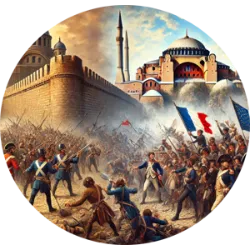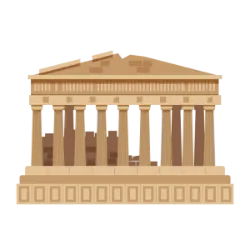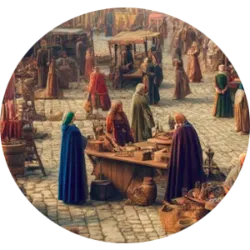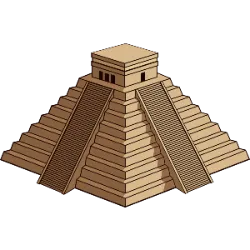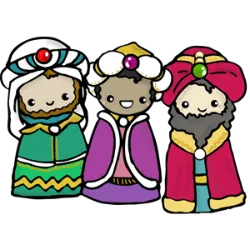Fall of Constantinople (1453)
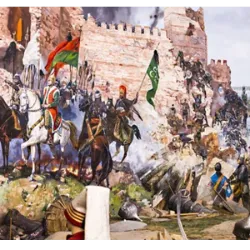
On May 29, 1453, the Ottoman Empire, led by Mehmed II, conquered Constantinople, the former capital of the Byzantine Empire, putting an end to more than a thousand years of history for the city. The fall of the city was a pivotal event that marked the end of the Middle Ages and the beginning of a new era for the Western world. The capture of Constantinople not only sealed the fate of the Byzantine Empire, but also profoundly altered the geopolitical and economic landscape of the time.
With the destruction of one of the most important trade routes between East and West, Europeans sought new alternatives for trade with the East. This gave rise to the Age of Navigation, with Portuguese and Spanish navigators seeking new sea routes to the Indies and other parts of Asia. The fall of Constantinople, therefore, not only marked the end of an empire, but also inaugurated a period of exploration and discovery that would transform global history for centuries to come.
Discovery of America (1492)
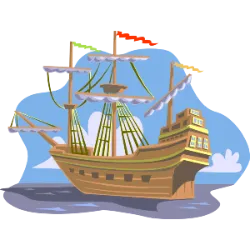
On October 12, 1492, Genoese navigator Christopher Columbus, in the service of the Catholic Monarchs of Spain, reached the American continent, more precisely the island of Guanahani in the Bahamas. Although Columbus believed he had reached the Indies, his arrival in the New World marked the beginning of one of the most significant events in history: the European colonization of the Americas.
Columbus' expedition, which was part of a search for new trade routes, paved the way for a series of voyages and discoveries that would lead European powers such as Spain and Portugal to expand across the American continent. This not only profoundly altered the global balance of power, but also began a process of exploration and colonization that had lasting impacts on the native populations and the world economy.
The discovery of America ushered in a new era of cultural, economic, and scientific exchange, but also resulted in centuries of European exploration and domination of the newly discovered lands. This event, considered a landmark in modern history, redefined relations between continents and forever altered the course of global history.
Test yourself with one of these challenges 👇
You can still go deeper with those who are experts in the subject: historiablog
Discover some interesting facts about MODERN AGE
Protestant Reformation (1517)
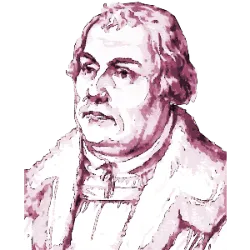
On October 31, 1517, the German monk Martin Luther posted his 95 Theses on the door of the Castle Church in Wittenberg, challenging the Catholic Church and its practices, especially the sale of indulgences. Luther questioned papal authority and defended the idea that salvation was achieved through faith, not through rituals or buying forgiveness, as the Church preached. This act marked the beginning of the Protestant Reformation, a movement that would divide Western Christianity and give rise to the creation of several Protestant denominations.
The publication of the 95 Theses spread quickly throughout Europe, thanks to the invention of the printing press, and generated intense theological and political debate. Luther not only questioned the practices of the Church, but also the foundations of its power and its influence over rulers. The movement that followed not only transformed religion, but also profoundly altered politics, with many princes and states adopting Protestantism as a way of weakening papal rule.
The Protestant Reformation resulted in the creation of new churches, such as Lutheranism and Calvinism, and had profound implications for the political, social and religious organization of Europe, being one of the most important landmarks in modern history.
Arrival of the Portuguese in Brazil (1500)
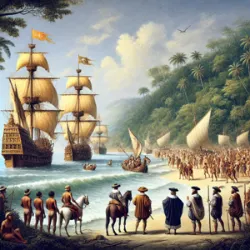
On April 22, 1500, Portuguese navigator Pedro Álvares Cabral, leading an expedition bound for the Indies, landed on the Brazilian coast, in the region that today corresponds to the state of Bahia. The historic event, which became known as the arrival of the Portuguese in Brazil, marked the beginning of Portuguese colonization in South America.
Initially, Cabral and his crew established contact with the local indigenous peoples, but without major confrontations. The arrival of the Portuguese was driven by the search for new trade routes and the expansion of the Portuguese empire, which was already prominent in maritime exploration. The territory, initially called "Ilha de Vera Cruz", was soon claimed for Portugal, according to the Treaty of Tordesillas, which divided the New World between Portugal and Spain.
The discovery of Brazil paved the way for the colonization and exploration of Brazilian lands, initially focused on the extraction of brazilwood, but which would expand over the centuries, with the establishment of an economy based on the production of sugar, coffee and other products. Cabral's arrival had a profound impact, altering the destiny of Brazil and transforming the region into one of the greatest colonial empires in history.
Foundation of the Society of Jesus (1540)
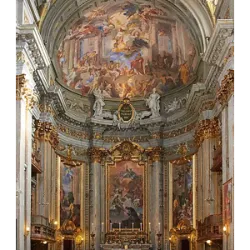
On August 15, 1534, the Spanish priest Ignatius of Loyola, together with a group of companions, founded the Society of Jesus, also known as the Jesuit Order. This event occurred in the context of the Modern Age, a historical period that extends from the 15th century to the end of the 18th century. The creation of the Society of Jesus is closely linked to the Protestant Reformation, a religious movement initiated by Martin Luther in 1517, which caused a division in the Catholic Church and generated intense religious disputes in Europe.
The mission of the Jesuits was to reaffirm the authority of the Pope and the Catholic Church, responding to the growth of Protestantism and the increasing secularization of European society. The Order stood out for its emphasis on education, the promotion of charitable works and missionary work, playing a fundamental role in the Counter-Reformation. Jesuits such as Francis Xavier brought Christianity to many parts of the world, including Asia and Latin America.
The Society of Jesus established itself as one of the most powerful religious orders in the history of the Church, with a lasting influence in areas such as education, science and politics, especially until the 18th century, when it was temporarily suppressed by Pope Clement XIV.
Council of Trent (1545-1563)

The Council of Trent, held between 1545 and 1563, was one of the most significant events in the history of the Catholic Church, convened to combat the Protestant Reformation and reinforce Catholic doctrine. In response to the movement initiated by Martin Luther in 1517, which challenged papal authority and church practices, the Council sought to reform the institution internally, condemning Protestant heresies and establishing stricter doctrinal and disciplinary norms.
The Council was a landmark of the Counter-Reformation, a movement that aimed not only to preserve Catholic principles, but also to restore the Church's influence over Europe. During its sessions, which took place in several stages over 18 years, dogmas such as the importance of tradition and Scripture, indulgences, and the vital role of the sacraments were reaffirmed. In addition, the Council reinforced papal authority and made significant internal reforms, combating abuses and promoting greater morality among the clergy.
The impact of the Council of Trent was lasting, influencing art, education, and religious practices for centuries. It helped solidify the identity of the Catholic Church and shape the religious and political landscape of the modern age, particularly during the height of the Counter-Reformation.
Scientific Revolution
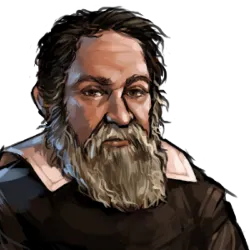
Between the 16th and 17th centuries, the Scientific Revolution marked a radical change in human knowledge, challenging medieval beliefs and establishing the foundations of modern science. Great names such as Nicolaus Copernicus, Galileo Galilei and Isaac Newton revolutionized astronomy and physics, replacing old Aristotelian concepts with methods based on observation and experimentation.
In 1543, Copernicus published the heliocentric theory, stating that the Earth revolved around the Sun, contradicting the geocentric view defended by the Church. In the 17th century, Galileo, using the telescope, confirmed this theory and defied the Inquisition, being tried for heresy. Shortly thereafter, Newton formulated the laws of motion and gravity, cementing the scientific method and the mechanistic view of the universe.
The Scientific Revolution not only transformed astronomy and physics, but also influenced philosophy and technology, paving the way for the Enlightenment and the advances of modernity. This period redefined the relationship between science and religion and shaped the contemporary world, establishing reason as the pillar of human knowledge.
Test yourself with one of these challenges 👇
HOME
